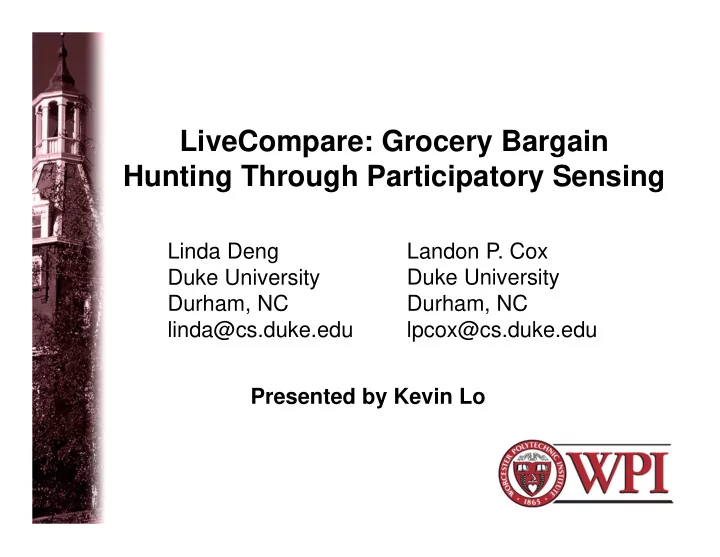

LiveCompare: Grocery Bargain Hunting Through Participatory Sensing Linda Deng Landon P. Cox Duke University Duke University Durham, NC Durham, NC linda@cs.duke.edu lpcox@cs.duke.edu Presented by Kevin Lo
Motivation • People still prefer purchasing grocery and household items from brick and mortar stores • No way to easily compare prices between 2 nearby stores – Same roll of toilet paper cost twice as much at CVS • Some price comparison services exist, but mostly for online merchants 2 Worcester Polytechnic Institute
Related Work • Micro-Blog: platform for sharing geotagged multimedia blogs; no incentives for sharing. • ShopSavvy: rely on online databases so not suitable for items not found online (false now) • MobiShop: participatory sensing through receipt scanning – Receipt scanning: optical character recognition (OCR) error prone & hard to insert into database – No incentives 3 Worcester Polytechnic Institute
Design • Uses the camera on the phone to take a picture of the price tag, which also contains the item’s UPC barcode 4 Worcester Polytechnic Institute
Design (p2) • Decode the barcode from the photograph using barcode libraries such as ZXing • LiveCompare transfers a smaller lower- quality image to the server (faster transfer) for database update 5 Worcester Polytechnic Institute
Design (p3) • It also sends its GPS or GSM cell information to the server for location/store identification • Presents the raw photographic data to users – Optical character recognition (OCR) is bad – No manual inputs needed thus better data integrity • Incentives: users can query for cheaper prices by submitting data at the same time 6 Worcester Polytechnic Institute
Design (p4) • Data Integrity – Reduces operator error by submitting product identification and pricing in the same photograph. – Users can flag malicious entries for removal • Limitation – Does not scale down well; could use online DBs for small scale deployment – Generic-brand products cannot be easily compared – Privacy concerns; use pseudonym & anonymity network to hide IP address 7 Worcester Polytechnic Institute
Evaluation • CVS has its own set of barcodes 8 Worcester Polytechnic Institute
Evaluation (p2) • 3 thumbnails automatically generated on Nokia N95 8GB; largest one used (320x320) 9 Worcester Polytechnic Institute
Evaluation (p3) • Feasibility of GPS, Wi-Fi, and GSM localization: – Assisted GPS is able to quickly attain accurate coordinates for all of the stores in either the checkout area or just outside the entrance of the store, but useless deep within the store – Wi-Fi localization is not guaranteed, since not all stores have access points. – Using GSM is also insufficient at the granularity of single stores if they are close to each other – Best strategy is a hybrid approach 10 Worcester Polytechnic Institute
Questions? 11 Worcester Polytechnic Institute
Recommend
More recommend